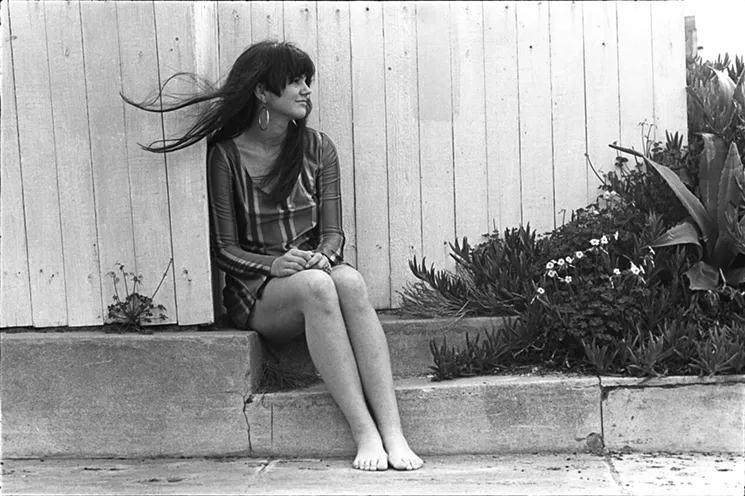I worry that someone will nominate me for one of those “10 albums that haven’t left my turntable” things on Facebook. Do I want my social media cadre to know how habitually I listen to Linda Ronstadt records? Often, let’s just say. Always.
Let me put it another way: Ronstadt’s Hasten Down the Wind album was released on August 1, 1976. I was standing outside Cheap Records that morning, clutching a $5 bill, when the store opened its doors. I played that album again yesterday, for perhaps the thousandth time, straining to hear something new.
Where Linda Ronstadt is concerned, I am that guy. If forced to, I could list for you each of her singles in the order of their release. And the B-sides, of course. I can tell you the catalog number of Prisoner in Disguise, the very best Ronstadt album ever recorded, and the chart positions of each of the three hits released from it. I know all the words to “She’s a Very Lovely Woman,” a stinkbomb of a single Ronstadt recorded in 1969. I’ll stop short of telling you what I once paid for “Everybody Has Their Own Ideas,” the very first Linda recording, released on a teeny indie label back when she was still with the Stone Poneys. But only because I don’t want you to think I’m insane.
The ’70s soundtrack of suburban America was scored with jangly three-note sing-alongs squeaked through AM airwaves, designed to sell long-players crammed with filler. But if “Blue Bayou” and “When Will I Be Loved” convinced us to buy Ronstadt LPs, we found something there other than filler. Between each of its Top 40 hits, each album was grooved with musical education.
For those of us raised on the pabulum of Top 40 radio, a Hank Williams song could be revelatory; an update of Oscar Hammerstein’s “When I Grow Too Old to Dream” could open our minds better than any dime bag. While other girl singers (imagine using that phrase today to describe a female vocalist) showed swagger hollering over a Pignose amp, Ronstadt did it by covering Motown, barely a decade after “Tracks of My Tears” and “Heat Wave” were still called “race records.”
Ronstadt’s liner notes were a Cliffs Notes of the about-to-be singer/songwriter movement. Who were Eric Kaz and J.D. Souther and Karla Bonoff? If you were a 15-year-old longing for music that meant something, the way Ronstadt made love to Kaz’s “Sorrow Lives Here,” or how she sounded harmonizing with Souther on his “Silver Blue” were an invitation to go find out.
I am speaking to the journalism students at the high school I attended 40 years ago. A slender young man with a beautiful mushroom-colored ponytail raises his hand. What, he wants to know, was the very first thing I ever had published? “Why, it was right here in your student newspaper,” I reply, suddenly aware (because I begin sentences with old-timey exclamations like “Why!”) that I am old enough to be this boy’s grandfather. “It was a review of the latest Linda Ronstadt album.”
The students exchange nervous glances, sly grins. “She was a singer,” their teacher provides helpfully from nearby. “She doesn’t sing anymore, though.”
“Is that because of your review of her record?” Mushroom Hair asks. His classmates titter happily.
I start to explain that Ronstadt has Parkinson’s disease, a nervous system disorder that prevents her from singing. Then I interrupt myself. “No,” I tell the class. “But it’s true I didn’t like the album very much, at least at the time. She was singing New Wave music and it just didn’t seem right, somehow. Elvis Costello called the album ‘a waste of vinyl.’”
The children stare back at me. I live in a world where young people — people who are the very age I was when Ronstadt’s records showed me the depth and breadth of popular music history — don’t know who Linda Ronstadt is. Or Elvis Costello. Rather than explaining about New Wave music, I change the subject.
What could I have told them? I wonder later, driving home while that New Wave album, Mad Love, plays too loudly through my boom-y auto speakers. Would I sound like an old fart if I tried to explain how Linda introduced kids their age to reggae, how her Nelson Riddle trilogy allowed us to admire the Great American Songbook?
I had tried, four decades earlier, to convince other teenagers on this same campus to reconsider Ronstadt. She was more, I kept telling my friend Michele, than “You’re No Good” and those Buddy Holly covers. Michele, who preferred Ann and Nancy Wilson, shrugged. I tried, in notes passed during Earth science class, to convince my pal Theresa to give Ronstadt a tumble. “You love Neil Young!” I scribbled. “You should hear Linda do his songs!” In response, Tess bought me a Carly Simon record for my 15th birthday. “Try Carly,” she wrote on the attached card. “She writes her own stuff.”
When I got home, I pulled out my Ronstadt stash — the same vinyl albums I’d spent all my teenage babysitting money and weekly allowance on; the CDs I’d strained to love as much as her middle-period stuff. I slipped on a pair of headphones and tried to listen differently, resisting that cheesy old adage about “the soundtrack of my life” and focusing instead on the recordings. Was Kenny Edwards really aping the octaves of Ed Black’s rhythm guitar part on “You’re No Good”? Was her Pirates of Penzance recording of “Poor Wandering One” really the first time she’d used her upper extension? I tried to stay focused, but my thoughts kept skittering away from the players, the lyrics, the arrangement.
After a while, I gave up. I gave in to Linda’s big, warm voice, the accompanying memory of its many musical invitations. Consider Hank Williams, that voice had called to me, back when country wasn’t cool. Go find Tracy Nelson and John Hall and Ry Cooder. In big, round, perfectly formed notes, Ronstadt’s voice had nudged me toward Patsy Cline and Frank Sinatra and Hoagy Carmichael and Steve Gillette. No, really, that voice is still singing to me. Go find the others. And this time, really listen.
A Linda Ronstadt Musical Primer
Here are 10 of my favorite Linda Ronstadt performances, in order of release.
“Orion” (Tom Campbell, 1966): A lover’s protest wrapped in an astronomy lesson, this acoustic cut from the first Stone Poneys album displays young Ronstadt’s big pipes and perfect pitch.
“We Need a Whole Lot More of Jesus (And a Lot Less Rock ’n’ Roll)” (Wayne Raney, 1969): This tongue-in-cheek Bible-thumper kicks off with a snaky bass riff by James E. Bond, and whips itself into a hoedown frenzy well before the bridge. It’s the best example of Ronstadt’s early alt-country stuff, from her first solo album.
“In My Reply” (Livingston Taylor, 1972): A classic of the country-rock subgenre that Ronstadt helped popularize, this sleepy ballad’s a stunner with a pedal steel solo from Sneaky Pete Kleinow. It’s from her eponymous third album (why do artists do that?); the version on 1974’s Different Drum compilation features a different vocal take.
“Faithless Love” (John David Souther, 1974): Heart Like a Wheel was Ronstadt’s breakthrough LP, and while it peeled off hit after hit, this heart-wrenching duet with Souther is the album’s big payoff. Sublime harmonies and Herb Pederson’s twangy banjo picking add to the magic.
“You Tell Me That I’m Falling Down” (Carol Hall, Anna McGarrigle, 1975): A standout track from Prisoner in Disguise harks back to Ronstadt’s folkie roots with a simple melody and a stubborn message about romantic freedom. There’s a sweet harmony vocal by Maria Muldaur. And are those bagpipes? Yes, they are — played by music maestro Andrew Gold.
“Lo Siento Mi Vida” (Kenny Edwards, Linda Ronstadt, Gilbert Ronstadt, 1976): Well before she recorded a trio of Spanish-language mariachi albums, there was this, a haunting track from Hasten Down the Wind. Written with her father and former Stone Poney Kenny Edwards, this is my personal favorite Linda recording.
“Falling Star” (Karla Bonoff, 1978): Recorded for her Living in the USA collection but released some 20 years later (on the multidisc Linda Ronstadt Box Set), this one marries Ronstadt’s head and chest vocals to great effect. Check out her final note, falling and dipping around Don Grolnick’s electric piano.
“I Get Along Without You Very Well” (Hoagy Carmichael, Jane Brown Thompson, 1986): It’s all here in this cut from Ronstadt’s last of the three American Standards albums with bandleader Nelson Riddle: Linda’s controlled vibrato; her arena singer’s belt; her understated approach to a classically romantic lyric.
“Just Like Tom Thumb’s Blues” (Bob Dylan, 1998): Ronstadt’s first Dylan cover since her debut solo album almost 30 years earlier, this We Ran track starts small (with a duet between Bernie Leadon’s mandocello and Mike Campbell’s electric guitar) and winds up big (with Ronstadt’s angry, gorgeous tonic note).
“Never Will I Marry” (Frank Loesser, 2004): From her last solo album, a collection of standards performed by a jazz combo, the vocal arrangement here is an homage to Nancy Wilson’s 1961 performance. Ronstadt does Wilson one better with a big, brassy sustained note at the end.
[
{
"name": "Air - MediumRectangle - Inline Content - Mobile Display Size",
"component": "18478561",
"insertPoint": "2",
"requiredCountToDisplay": "2"
},{
"name": "Editor Picks",
"component": "16759093",
"insertPoint": "4",
"requiredCountToDisplay": "1"
},{
"name": "Inline Links",
"component": "17980324",
"insertPoint": "8th",
"startingPoint": 8,
"requiredCountToDisplay": "7",
"maxInsertions": 25
},{
"name": "Air - MediumRectangle - Combo - Inline Content",
"component": "16759092",
"insertPoint": "8th",
"startingPoint": 8,
"requiredCountToDisplay": "7",
"maxInsertions": 25
},{
"name": "Inline Links",
"component": "17980324",
"insertPoint": "8th",
"startingPoint": 12,
"requiredCountToDisplay": "11",
"maxInsertions": 24
},{
"name": "Air - Leaderboard Tower - Combo - Inline Content",
"component": "16759094",
"insertPoint": "8th",
"startingPoint": 12,
"requiredCountToDisplay": "11",
"maxInsertions": 24
}
]











